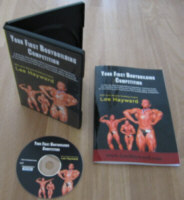Tuesday, March 3, 2009
How Big Should A Well Developed Muscular Body Be?
When it comes to "bodybuilding" in the pure sense (i.e. building your body) there needs to be a method in place by which you can measure your progress and know when you have arrived at your ideal muscular destination.
Rather then aimlessly lifting and pumping iron day after day with no real goal in sight, there has to be something by which you can judge your progress by and know when you have made it. Otherwise how will you ever know when you can ring the bell and have the satisfaction of announcing to the world that you have gone from being small, skinny and scrawny to big, buff and brawny.
Now with that being said, I don't believe that there should ever be an end to working out. It is something you need to do as part of your lifestyle. If for nothing else then just the health benefits that regular exercise provides. But it would be nice to have a goal to shoot for
I've been doing some reading about various ways to judge your muscle building progress. And while there is no cut and dried answer to the question "How Big Should You Be?" there are some good guidelines that you can follow.
The simple system that I'm about to share with you here can be used as the yardstick by which you measure your bodybuilding progress.
Bodyweight
Let's start off with the easiest method by which to monitor your muscle building progress - bodyweight. The first thing to keep in mind here is that "normal" bodyweights that these body mass index charts use (such as the ones that life insurance companies and doctors tend to use) are not relevant to a well-developed muscular body.
Also a given bodyweight is no guarantee of a particular level of muscle size or strength. So treat your bodyweight as a guideline, not an absolute rule.
Start with a baseline bodyweight of 100 lbs. for a person who is 5 foot tall. And then add 10 lbs. for every inch in height. So a man who is 5'10 tall should weigh approx. 200 lbs. that would be considered an average build. Then for a muscular build add 30-40 lbs. to that weight. So a well built muscular man who is 5'10 tall should weigh around 230+ lbs.
Remember again that this is just a guideline, some people will be able to carry more or less size depending on their particular body type and structure. Someone with a smaller frame and smaller bone structure would look bigger at a certain bodyweight then someone else who has a large frame and heavier bone structure. This is evident in bodybuilding competitions where sometimes a lighter weight class competitor may actually look bigger then some of the heavier weight class competitors.
But again just calculate your baseline bodyweight from this simple formula and you'll get a good idea of how much size you'll need to gain to have a "muscular build".
Tomorrow I'll cover another method of monitoring your bodybuilding gains by showing you a formula for calculating out your body size and proportions.
Rather then aimlessly lifting and pumping iron day after day with no real goal in sight, there has to be something by which you can judge your progress by and know when you have made it. Otherwise how will you ever know when you can ring the bell and have the satisfaction of announcing to the world that you have gone from being small, skinny and scrawny to big, buff and brawny.
Now with that being said, I don't believe that there should ever be an end to working out. It is something you need to do as part of your lifestyle. If for nothing else then just the health benefits that regular exercise provides. But it would be nice to have a goal to shoot for
I've been doing some reading about various ways to judge your muscle building progress. And while there is no cut and dried answer to the question "How Big Should You Be?" there are some good guidelines that you can follow.
The simple system that I'm about to share with you here can be used as the yardstick by which you measure your bodybuilding progress.
Bodyweight
Let's start off with the easiest method by which to monitor your muscle building progress - bodyweight. The first thing to keep in mind here is that "normal" bodyweights that these body mass index charts use (such as the ones that life insurance companies and doctors tend to use) are not relevant to a well-developed muscular body.
Also a given bodyweight is no guarantee of a particular level of muscle size or strength. So treat your bodyweight as a guideline, not an absolute rule.
Start with a baseline bodyweight of 100 lbs. for a person who is 5 foot tall. And then add 10 lbs. for every inch in height. So a man who is 5'10 tall should weigh approx. 200 lbs. that would be considered an average build. Then for a muscular build add 30-40 lbs. to that weight. So a well built muscular man who is 5'10 tall should weigh around 230+ lbs.
Remember again that this is just a guideline, some people will be able to carry more or less size depending on their particular body type and structure. Someone with a smaller frame and smaller bone structure would look bigger at a certain bodyweight then someone else who has a large frame and heavier bone structure. This is evident in bodybuilding competitions where sometimes a lighter weight class competitor may actually look bigger then some of the heavier weight class competitors.
But again just calculate your baseline bodyweight from this simple formula and you'll get a good idea of how much size you'll need to gain to have a "muscular build".
Tomorrow I'll cover another method of monitoring your bodybuilding gains by showing you a formula for calculating out your body size and proportions.
Subscribe to:
Post Comments (Atom)














I believe in starting at a 100 lbs for 5ft, but instead of 10lbs, adding 5 lbs per inch. at 5'10, 200 lbs would be way heavy. According to doctor's a 'normal' weigh for me (I am 6'4) is between 170-200 lbs.
ReplyDeleteI disagree with your formula. I am 5foot 5inches. This would put me at 150 baseline. Adding 30-40 would be 180-190. I am 148 lbs at age 37 and would think another 30+ lbs of muscle on me would be insane.
ReplyDeleteI think 5'5" would be base 130 and heavily muscled 160-170
Latest pic:
http://louisvilletemples.com/ct.jpg
You should lower your 10 lbs per inch or make it a progressive scale.
Another great post but the bodyweight formula seems a bit exaggerated. I am 6'1". That would figure out to a 230lb basic build and 260-270 muscular. Thats huge and there is no way I could ever hit weights like that. Well, not naturally anyway.
ReplyDeleteLee,
ReplyDeleteI loved your article on How Big Should a Well Developed Muscular Body Be? What about a female? Should a female weight lifter use the same guidelines to determine what her weight should be?
These numbers are not the "normal" bodyweights that body mass index charts use. These are numbers for maximum muscular bodyweight.
ReplyDeleteNow I realize that not everyone wants to maximize their muscular size and that's fine. To each their own. But for those who do want to build a big muscular physique these are some good numbers to aim for.
And the numbers are not over the top for maximum muscle mass. I'm actually bigger then these numbers. I'm 5'6 1/2 tall (let's just round it off to 5'7) and my current bodyweight is 220 lbs. So that would put my baseline weight at 170 lbs. and I'm actually 50 lbs. bigger then baseline.
As for the female numbers I don't know off hand. But judging by the female bodybuilders that I know of personally, the baseline numbers used here would be a very muscular build for a woman.
ReplyDeleteActually guys, his formula is pretty good. I am 6'2" 330 lbs, (Defensive Lineman), but currently 26% bodyfat. That would put my lean body mass at around 240lbs. Now certainly this is not 'average' size, but I have naturally gotten up to about 265lbs of lean mass with around 18% BF right before the season without too much problem. If I could get down to >10% bodyfat, I am sure that I would look pretty ripped at that amount of mass. Stick with the BF% and you should do fine and look more powerful with some extra muscle.
ReplyDeleteP.S. My mass-building diet uses about 5,200 Calories/day and I consider myself to have a moderate to slow metabolism.
Lee
ReplyDeletewhat about a female's measurement for idealporportions and size and muscularity? how can a female set training goals to compete?
The formula should have a variable for frame size. At 6'3" tall my wrist circumference is 6.5". I'm good size at 200 lbs. Your formula would have me at 280 lbs. I would be a super muscle freak at 280 lbs with a 30" waist.
ReplyDelete